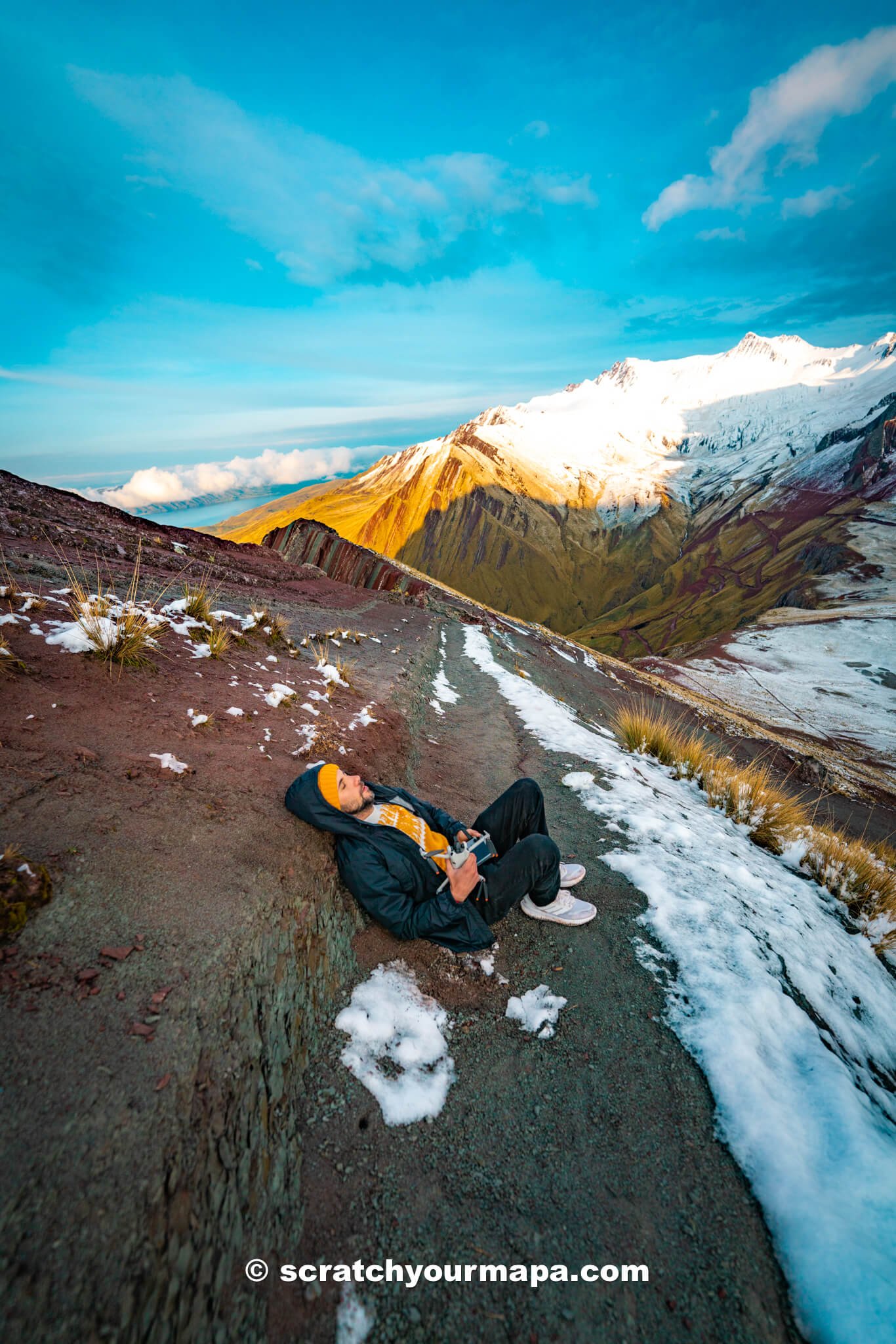Preventing Altitude Sickness in Peru: Tips for a Healthy Adventure
Planning a trip to Peru’s breathtaking highlands? Whether it’s hiking the Inca Trail or exploring Cusco, knowing how to prevent altitude sickness in Peru is crucial for enjoying your adventure. This guide will help you prepare for the high altitudes and ensure your trip is unforgettable for all the right reasons.
Altitude sickness can impact anyone, regardless of fitness level, and the symptoms can range from mild headaches to more severe issues. Even as a couple that is well-traveled and very healthy, the high altitudes hit us hard, and we're determined to make sure you don't suffer like we did.
By understanding how to acclimate, recognizing symptoms early, and following proven tips, you can stay safe and comfortable throughout your journey. With these insights, you’ll feel confident tackling Peru’s majestic landscapes, one breathtaking view at a time.
*Please note that this blog post may contain some affiliate links, which we make a small profit on, at zero cost to you. Links are only used on products & services that we've used and believe in, to give you the best buying experience. Purchasing from these links helps us to continue providing free travel guides for you- so thank you for your support!
Our Travel Planning Recommendations


🎫 Get Your Guide (tours)

📸 Best Buy (equipment)
🚗 Rental Cars (car rentals)




Preventing Altitude Sickness in Peru: A Quick Intro
Altitude sickness, also known as acute mountain sickness (AMS), is a common challenge for travelers visiting Peru’s high-altitude regions like Cusco, the Sacred Valley, and Lake Titicaca.
While the stunning scenery of this country is well worth the trip, preparation is key to ensuring your body adjusts smoothly to the thinner air.
This guide offers tips and insights to help you preventing altitude sickness in Peru, so you can enjoy your journey to the fullest.
 How Common is Altitude Sickness in Peru?
How Common is Altitude Sickness in Peru?
Altitude sickness is very common in Peru, especially for visitors arriving from sea level to high-altitude destinations like Cusco (11,152 feet/3,399 meters) or Puno (12,556 feet/3,827 meters).
Approximately 50% to 75% of travelers may experience symptoms when they ascend quickly without time to acclimatize, and some others will have more extreme symptoms (It's me, Hi, I'm the problem - it's me).
How To Travel Cheaper and Better in 15 minutes!
How much more would you travel, if it costed you less resources?
With our Free eBook, you will learn how to save money and time on your future trips. Plus, you'll see the exact system we use.
Grab your copy for free when you sign up for our newsletter 👇

 How Bad is Altitude Sickness in Cusco?
How Bad is Altitude Sickness in Cusco?
In Cusco, the high altitude and thinner air mean oxygen levels are significantly reduced, which can lead to altitude sickness.
Symptoms range from mild discomfort, such as headaches and fatigue, to more severe cases, like shortness of breath, nausea, and insomnia. Most travelers experience only mild symptoms that subside within a few days with proper acclimatization.
I on the other hand, am from the beach, and am not used to high altitudes, so am much more sensitive. If you are from an area with a high altitude, or are traveling slowly from sea level to higher altitudes, you'll have a much lower chance of altitude sickness.

Cusco is one of the top cities in Peru where people get altitude sickness.
What are the Symptoms of Altitude Sickness in Peru?
Each person's symptoms may vary, but there are several ways to know you've been hit with altitude sickness.
Common symptoms of altitude sickness include:
- Headache
- Nausea or vomiting
- Fatigue or weakness
- Shortness of breath
- Insomnia
- Dizziness or lightheadedness
- Loss of appetite
- In severe cases, symptoms can progress to confusion, chest tightness, and inability to walk, which require immediate medical attention.
The first time we visited Cusco we went straight to sleep without taking anything for preventing altitude sickness, which was a BIG mistake. We ended up waking up at 2 AM out of breath, feeling extremely nauseous, dizzy, and weak.
We were hiking Vinicunca Rainbow Mountain and Fede also started to feel so sick that he almost passed out.
This time, we took all of the precautions for preventing altitude sickness in Peru. However, as soon as the pills wore off, I was greeted with insane headaches. My stomach was very uneasy, and it really affected my digestion if you know what I mean.

The higher up in the mountains you are, the worse altitude sickness becomes.
 Other Effects of Altitude Sickness
Other Effects of Altitude Sickness
Other than the most popular symptoms of altitude sickness, we also noticed a few other peculiarities in our bodies ever since we arrived in Cusco.
We started becoming very gassy, and were burping a lot. I knew it had to do with the altitude, as I'm not one to burp much. Then we researched a bit, and found that high altitudes can make you gassy.
This is due to the lower concentration of oxygen, which affects the bowels' ability to move digested food. Also, this is probably why our stomach's constantly felt a bit iffy.
Another funny thing we noticed is that our bodies were cracking a lot less. Okay, I know this sounds strange, but typically we are constantly cracking our backs, knuckles, etc. While we were in Cusco we noticed we were unable to crack like they usually do.
While there is no scientific evidence related to this, I'm convinced it was related somehow. It's not a massive issue, but figured I'd share my hypothesis with you.
Don't have time to read the whole article and want to save it for later? Just pin it!


Methods for Preventing Altitude Sickness in Peru
So now that you know that the altitude can really f*** up your body chemistry. But what you can do about it? Well, now's the part where we help you by sharing all of the methods for preventing altitude sickness in Peru.
 How to Beat Altitude Sickness in Peru
How to Beat Altitude Sickness in Peru
Luckily, Peruvians are very accustomed to altitude sickness, and they are super knowledgable about a variety of ways for preventing altitude sickness.
Here are all of the things that can help with preventing altitude sickness in Peru:
- Acclimate Yourself: Spend a day or two acclimating in lower-altitude regions, like the Sacred Valley, before heading to higher elevations like Cusco or Puno.
- Take an Altitude Sickness Pill: This is the most effective way for preventing altitude sickness in Peru.
- Stay Hydrated: Drink plenty of water to keep your body hydrated, which can help reduce symptoms.
- Eat Lightly: Stick to easy-to-digest foods, as heavy meals can worsen nausea.
- Avoid Alcohol: Alcohol dehydrates you and can exacerbate symptoms.
- Drink Coca Tea: Try drinking coca tea, a traditional remedy known for easing altitude-related discomfort.
- Chew on Coca Leaves: You can find dried Coca leaves, which some people chew in the back of their mouth and suck on the juice. It sounds kind of gross, but does help a lot.
- Acana: This local herb was given to us in the form of tea and it greatly helped my headache. We'd recommend asking locals how to find this, as there is little information online. It's very bitter and not pleasant to drink, but it was a life-saver!
- Muña: This is another herb that works for preventing altitude sickness in Peru, and comes in the form of tea or candies.
- Eucalyptus or Mint: Sniff this while hiking to prevent dizziness and give you a boost of energy
- Chocolate: We recommend having a little bit of chocolate during hikes to give you a boost of energy if you're not feeling your best.
- Cans of Oxygen: This sounds insane, but cans of oxygen can be a life saver for preventing altitude sickness in Peru.

A great way to help altitude sickness is by drinking Mate de Coca.
 Do I Need Altitude Sickness Pills in Peru?
Do I Need Altitude Sickness Pills in Peru?
We're not people that turn to pills often, but the altitude sickness pill was 100% necessary for us. While mate de coca and staying hydrated certainly help preventing altitude sickness in Peru, the pills are the real deal.
We had a few different types of pills. The first pharmacy we went to gave us two different pills to take together, and were life-savers!
The next day we went and a girl gave us all-natural pills to take. While this sounded much more ideal, we noticed they didn't work nearly as well.
Take the pill as soon as you arrive in Cusco! The altitude won't hit right away, but preventing altitude sickness in Peru beforehand is the key to surviving.
 How Do You Acclimate to the High Altitudes in Peru?
How Do You Acclimate to the High Altitudes in Peru?
Acclimatization involves allowing your body to adjust gradually to lower oxygen levels.
The best way to acclimate to high altitudes is to gradually visit places with higher altitudes. For example, visiting the Atacama Desert, then going to Uyuni, and gradually up will ensure you have a much more pleasant experience acclimating to the altitude.

You can go to other places with high altitudes (but lower than Cusco) to acclimate.
That being said, sometimes some of us are going from sea level (Lima for example) straight to Cusco. If this is the case, you'll want to take a pill and spend 1-2 days in the city before going to any of the Rainbow Mountains or other places with higher elevation.
Make sure not to do any crazy strenuous activities, stay hydrated, and have the pills handy when leaving Cusco to visit other locations.



Make sure you are acclimatized before going to the rainbow mountains!
 How Do You Know if You are Acclimatized?
How Do You Know if You are Acclimatized?
You’re acclimatized when you no longer feel symptoms of altitude sickness, such as headaches or dizziness, and can perform light physical activities without fatigue or shortness of breath.
Acclimatization typically takes 1-3 days, but can really depend on your body and altitude level. Having grew up at sea level, I am EXTREMELY sensitive to altitude sickness, and unfortunately had symptoms for a full week.
Every person is different, but we recommend being fully prepared, especially when hiking and going to places with extremely high altitudes.
Travel Planning Tools
Here are some useful tools that you can use for planning your upcoming trip!
Peru is an incredible destination, and the area of Cusco is definitely one of our favorites in the country. Feeling sick definitely can make a big impact on your trip, so we hope that our guide for preventing altitude sickness in Peru will help you greatly during your travels!
Want to learn about all of the fun things to do in Cusco and around the area? We have quite a few Cusco guides, as well as plenty of other Peru travel guides for you to enjoy. Make sure to subscribe to our newsletter, as we are publishing new content on this incredible country each week!
Ready to start creating an awesome Peru itinerary? Well, we're here to help! Scratch Your Mapa offers custom travel planning services, to help you build the most unique trip ever. Want to learn more? Shoot us an email for your free consultation!

Here are some other articles you'll find helpful:
Like this article? Please share it with your family and friends, so that we can continue to keep creating free travel guides for you! It takes just a second, and would mean the world to us. Thanks for being here!




 How Common is Altitude Sickness in Peru?
How Common is Altitude Sickness in Peru? How Bad is Altitude Sickness in Cusco?
How Bad is Altitude Sickness in Cusco? Other Effects of Altitude Sickness
Other Effects of Altitude Sickness

 How to Beat Altitude Sickness in Peru
How to Beat Altitude Sickness in Peru Do I Need Altitude Sickness Pills in Peru?
Do I Need Altitude Sickness Pills in Peru? How Do You Acclimate to the High Altitudes in Peru?
How Do You Acclimate to the High Altitudes in Peru? How Do You Know if You are Acclimatized?
How Do You Know if You are Acclimatized?





